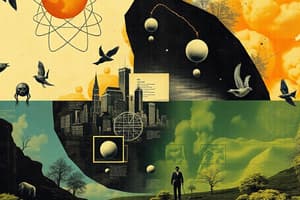Podcast
Questions and Answers
What are the two main types of cells?
What are the two main types of cells?
- Prokaryotic and Eukaryotic (correct)
- Mitochondrial and Ribosomal
- Unicellular and Multicellular
- Animal and Plant
Which of the following is NOT one of the five kingdoms of classification?
Which of the following is NOT one of the five kingdoms of classification?
- Animalia
- Protozoa (correct)
- Fungi
- Monera
Where does photosynthesis primarily occur in green plants?
Where does photosynthesis primarily occur in green plants?
- Nucleus
- Mitochondria
- Ribosomes
- Chloroplasts (correct)
Which components are part of an ecosystem?
Which components are part of an ecosystem?
What does Mendel's law of segregation refer to?
What does Mendel's law of segregation refer to?
What type of adaptation is camouflage in animals considered?
What type of adaptation is camouflage in animals considered?
Which of the following best describes one phase of a life cycle?
Which of the following best describes one phase of a life cycle?
Which current trend in life sciences focuses on protecting endangered species?
Which current trend in life sciences focuses on protecting endangered species?
Flashcards are hidden until you start studying
Study Notes
Life Sciences Overview
- Life sciences encompass the study of living organisms and their interactions with the environment.
- Key disciplines include biology, ecology, genetics, and microbiology.
Major Concepts
-
Cells
- Basic unit of life.
- Two main types: prokaryotic (no nucleus, e.g., bacteria) and eukaryotic (nucleus, e.g., plants, animals).
-
Classification of Living Organisms
- Taxonomic hierarchy: Domain, Kingdom, Phylum, Class, Order, Family, Genus, Species.
- Five Kingdoms: Monera, Protista, Fungi, Plantae, Animalia.
-
Photosynthesis
- Process by which green plants convert sunlight into chemical energy.
- Occurs mainly in chloroplasts using chlorophyll.
- Equation: CO2 + H2O + sunlight → C6H12O6 + O2.
-
Ecosystems
- Composed of living (biotic) and non-living (abiotic) components.
- Energy flow: Producers (plants) → Consumers (animals) → Decomposers (fungi, bacteria).
-
Genetics
- Study of heredity and variation in organisms.
- DNA structure: double helix, made up of nucleotides (A, T, C, G).
- Mendel's laws: principles of inheritance (dominance, segregation, independent assortment).
-
Human Body Systems
- Major systems:
- Circulatory: Transports blood, nutrients, gases.
- Respiratory: Facilitates gas exchange (O2 in, CO2 out).
- Digestive: Breakdown of food, nutrient absorption.
- Nervous: Controls body functions via signals (brain, nerves).
- Major systems:
-
Adaptations
- Structural, physiological, and behavioral adaptations help organisms survive.
- Examples:
- Camouflage in animals.
- Photosynthetic adaptations in plants (leaf structure).
-
Life Cycles
- All living organisms undergo different life stages (e.g., birth, growth, reproduction, death).
- Examples: Metamorphosis in insects (egg → larva → pupa → adult).
Importance of Life Sciences
- Understanding life sciences helps in health, environmental conservation, and biotechnology.
- Provides insights into biodiversity, ecosystem balance, and species conservation.
Current Trends
- Biotechnology: Genetic modification and cloning.
- Environmental science: Studying climate change effects on ecosystems.
- Conservation biology: Protecting endangered species and habitats.
Life Sciences Overview
- Study of living organisms and their interactions with the environment
- Includes biology, ecology, genetics, microbiology
Cells
- Basic unit of life
- Two main types: prokaryotic (no nucleus, e.g., bacteria) and eukaryotic (nucleus, e.g., plants, animals)
Classification of Living Organisms
- Taxonomic hierarchy: Domain, Kingdom, Phylum, Class, Order, Family, Genus, Species
- Five Kingdoms: Monera, Protista, Fungi, Plantae, Animalia
Photosynthesis
- Process by which green plants convert sunlight into chemical energy
- Occurs mainly in chloroplasts using chlorophyll
- Equation: CO2 + H2O + sunlight → C6H12O6 + O2
Ecosystems
- Composed of living (biotic) and non-living (abiotic) components
- Energy flow: Producers (plants) → Consumers (animals) → Decomposers (fungi, bacteria)
Genetics
- Study of heredity and variation in organisms
- DNA structure: double helix, made up of nucleotides (A, T, C, G)
- Mendel's laws: principles of inheritance (dominance, segregation, independent assortment)
Human Body Systems
- Major systems:
- Circulatory: Transports blood, nutrients, gases
- Respiratory: Facilitates gas exchange (O2 in, CO2 out)
- Digestive: Breakdown of food, nutrient absorption
- Nervous: Controls body functions via signals (brain, nerves)
Adaptations
- Structural, physiological, and behavioral adaptations help organisms survive
- Examples:
- Camouflage in animals
- Photosynthetic adaptations in plants (leaf structure)
Life Cycles
- All living organisms undergo different life stages (e.g., birth, growth, reproduction, death)
- Examples: Metamorphosis in insects (egg → larva → pupa → adult)
Importance of Life Sciences
- Understanding life sciences helps in health, environmental conservation, and biotechnology
- Provides insights into biodiversity, ecosystem balance, and species conservation
Current Trends
- Biotechnology: Genetic modification and cloning
- Environmental science: Studying climate change effects on ecosystems
- Conservation biology: Protecting endangered species and habitats
Studying That Suits You
Use AI to generate personalized quizzes and flashcards to suit your learning preferences.




